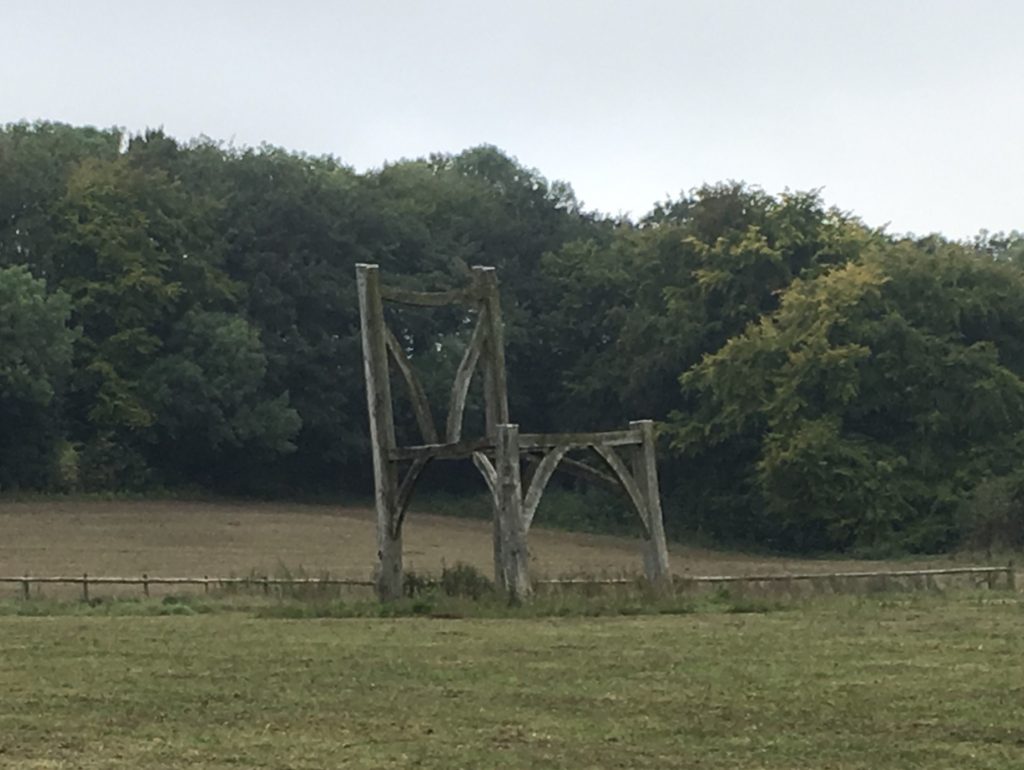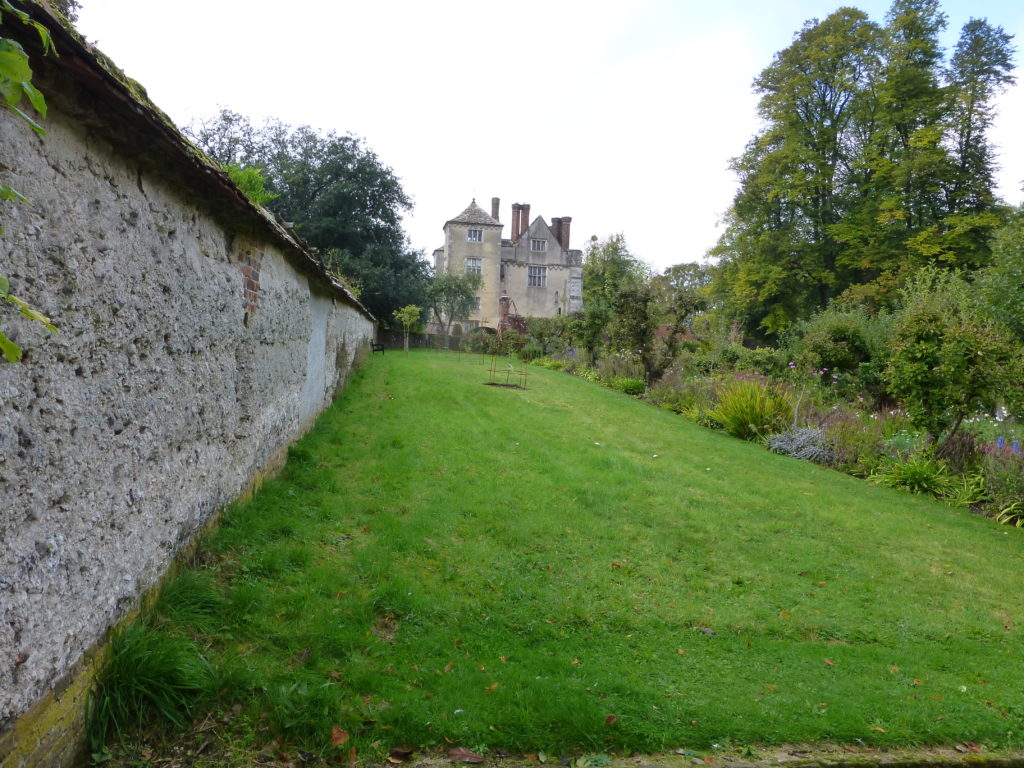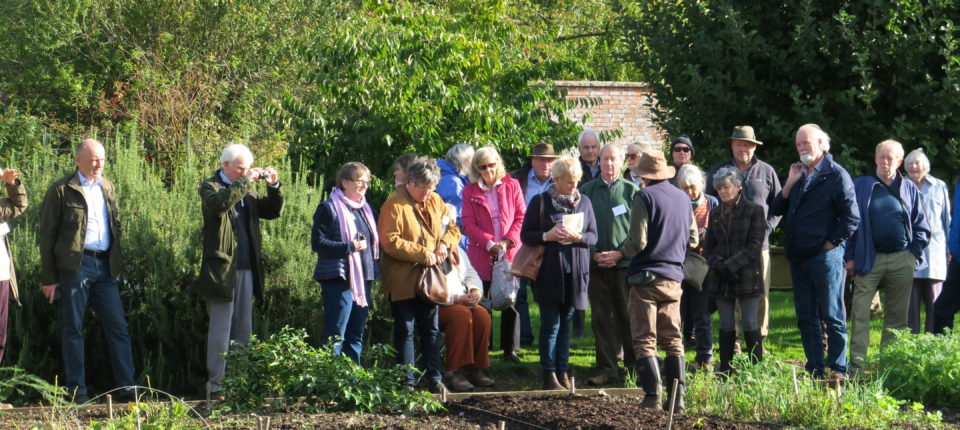For those arriving on the Friday, ready for the 2019 WKGN Forum at Cranborne in Dorset, the informal pre-Forum dinner was very welcome; a great chance to rest and recharge the batteries while enjoying not only the food but the renewal of old acquaintances, making new ones, and generally enjoying the conviviality thanks, in no small part, to the continued and generous support of Alitex
Saturday started in the ‘Garden Room’ at Cranborne with ‘Lapel Label Lucy’ (Pitman) in her usual role of ensuring that everyone had a name-badge to wear. While the weather outside was a little grey, it looked promising for the weekend, and did indeed brighten-up later on Saturday.
The Forum was formally opened by Susan Campbell welcoming everyone and outlining the day ahead. The theme of ‘Walled Kitchen Gardens used as Garden Centres and Nurseries’ gave us a real spectrum of what that actually means, starting with Patrick Fairweather.
‘Patrick’s Patch’ is seen very much as a community project, whilst still driving it forward as a business. Schools, and other groups, are encouraged to get involved at the events organised at Fairweather’s, re-engaging them with the garden-to-plate ethos; an idea lost to so many of our youngsters (and often their parents, too). Not lost on Fairweather’s, though, as the garden-supplied cafe provides a goodly proportion of their income (a common sub-theme to the weekend). Although we discovered that the experimental walls, built when the garden came into being, may have been a mistake, the exclusive match-making service they supplied at that time was perfect.
Although originally giving the impression that her research had been totally accidental, our second speaker, Charlotte Casella gave a really interesting talk on the history of Cranborne, including that Cranborne Manor was built originally as a hunting lodge for the Cecil family, even though they never really lived there. The estate was run by their steward, who lived in Cranborne Lodge, and the walled garden was built by/for him. Other research showed up evidence that part of the land had once been a plague burial ground. Hmmm, time for a coffee break.
The third talk was by Georgiana Campbell (no relation), the current incumbent of Cranborne Manor, who delivered hers as she guided us round, first the garden centre walled garden, and then through the manor house’s own gardens. Each garden ‘room’ a delight, with features and vistas guaranteed to cause envy: a ‘mount’, a wizened apple tree even older than me, and a chair big enough to sit us all on in one go (though no-one did).

The Walled Garden’s walls were a new thing to many of us, made from a type of cob derived from the local chalk called ‘clunch’. Seemingly a local ‘thing’, we found it at some of the other gardens on the Sunday, too. Due to the nature of the building material, the top would possibly have been thatched, originally. I think that all the examples we saw, now have a ridged tile coping.

After lunch Richard and Jill Rallings, of Mynd Hardy Plants in Shropshire, took us through their experience of how their wine-making origins took them to Delbury Hall Walled Gardens, and the daunting task of taking an overgrown Daylily nursery and turning it into the Daylily and Penstemon Mecca it is today. Plenty of cautionary tales for those thinking of following in their footsteps. Check the contract wording carefully, methinks.
Next up was Mark Pitman (relation), who looks after a bit of the John Lewis/Waitrose empire that most people don’t seem to know about. Longstock Park Nursery is part of the Leckford Estate. As well as the estate providing produce for the Waitrose stores (everything from mushrooms to wine, and fruit to flour), the nursery sits in and around the old walled garden. Famous for their National Collections of Clematis Viticella and Buddleja, at one time the nursery specialised in roses. Now it seems to cover all kinds of plants, through to trees from fruit to highly ornamental. Here, again, the dilemma of a growing demand for the profitable cafe has meant it has outstripped the space available.
Sadly, the 5th speaker listed for the day, Andrew Haynes, head gardener at Edmondsham House, couldn’t make it. It was due to a back problem preventing him from sitting, especially in a car. So we had a quick introduction to Edmondsham from the owner, Julia Smith, and a promise that we should see Andrew when we visited Edmondsham, the first stop on Sunday.
Before a general discussion, Claire Whitehead, who manages Cranborne Garden Centre answered questions about her role and how she came to Cranborne. As ‘accidental’ as Charlotte’s research, with a return to her Dorset roots, came the offer to run the garden centre. Despite no previous experience of such a venture, Claire could see the potential and, with the introduction of the ‘Garden Room’, has expanded the business, including the Wedding and catering/hospitality side.
Although that concluded Saturday’s formal proceedings, after a break to freshen up, many delegates reconvened back at the Garden Room for a short evening reception, where there was much discussion, continued from earlier in the day. A brief sojourn at the pub for a nightcap brought an excellent first day to a close.
If anything, the weather was brighter first thing on Sunday, though there was a brisk, cool wind at times during the day. Car-shares organised, we departed from Cranborne for the first, and nearest, garden visit of the day, Edmondsham.
Luckily, as well as Julia (who stayed with us for the rest of Sunday, too), Andrew was there to meet us outside the walled garden. Following organic principles since his arrival in 1984, Andrew now uses the ‘no-dig’ method, mulching the 3-foot wide beds once a year. The mulch, mainly derived from leaves and grass-clippings, allows the worms and bacterial and fungal rhizosphere to do their job before being planted-up (when he uses the ‘puddling’ watering method). There were audible gasps when Andrew plunged his fist into a bed, as it sank in several inches below the mulch level, completely unimpeded. Andrew also described how he maintains his compost bins and wormery. However, the back-sheds, which appeared unchanged from how they might have looked 150 years ago, also garnered a great deal of attention, as did the curvilinear peach house.
At the National Trust’s Kingston Lacy (the one garden today where there wasn’t an actual wall around it) we were met by Chris Cooper, who had been very helpful in arranging for us to visit. After a quick introduction, we were free to wander around the numerous Weekes & Co., glasshouses, recently restored and looking magnificent – the enormous vinery in particular. That said, although this is a visitor attraction, the details that interest the likes of us are there too: the back-sheds; wooden roller slat-blinds; and a peep through the window into the stokehole! The intention is to restore the the productive area of the garden (currently a Maize Maze) to a similar standard as the glasshouses.
Lunch beckoned so, onwards to Long Crichel to be met by Rose and Jamie Campbell (still no relation but they are old friends of Susan), who then fed us superbly with produce from their walled garden, followed by the most heavenly slice of almond tart. With barely time to digest it, we then were taken round the garden by Jamie, describing the parlous state it was in when they arrived (another example of ‘clunch’ walls and what probably happens when the coping fails). The gardener, Annie, follows the Bio-Dynamic method, which not only seems to give superb results but, from what she said, a more relaxed and less stressful life. There’s no shortage of potash for the garden, as Long Crichel is also home to the wood-fired, ‘Famous Hedgehog Bakery’. Jamie also gave us a quick talk in the bakery, too, before we dashed off to Deans Court at Wimborne Minster.
At Deans Court we were met by Sir William Hanham who took us around his walled garden where the organic traditions started by Sir William’s mother continue to be used, including ‘no-dig’ again as part of the ‘permaculture’ approach. The garden supplies all the needs of the family and the cafe. So much so, that they don’t really need all the garden to do that, and are looking at other uses for the surplus garden space. The south and west sides of the garden are protected by the longest serpentine wall I think I’ve ever seen. In the ‘pleasure grounds’ around the house are some enormous trees, including a very old Swamp Cypress and Tulip tree. The actual date of their arrival from America seems open to debate but definitely in the ‘a very long time ago’ bracket, given the girth of the former being eight metres, according to Sir William. The rectangular lake has a history to it but thoughts of it being Saxon in origin have latterly given way to it probably being Roman, given some archaeological finds that have emerged.
With a heavy heart, we said our goodbyes and thanked Lucy, Susan and Mike for yet another fabulous Forum, already anticipating the next one. See you all in 2020!” ROB WILLETS

